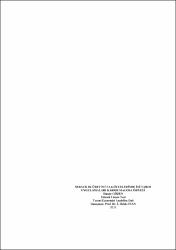| dc.contributor.author | Gözen, Hande | |
| dc.date.accessioned | 2017-05-05T07:28:59Z | |
| dc.date.available | 2017-05-05T07:28:59Z | |
| dc.date.issued | 2010 | |
| dc.identifier.uri | https://hdl.handle.net/20.500.11776/740 | |
| dc.description.abstract | Dünya'da son yıllarda yaşanan gelişmeler, tarım sektöründe modern teknolojinin ve üretim girdilerinin aşırı kullanımına yol açmıştır. Sonuç olarak tarım ürünlerinde kimyasal kalıntıların görülmesine ve kirlenen tarım toprakları nedeniyle yer altı sularında nitrat birikmesine neden olmuştur. Tarımda yaşanan bu olumsuzluklar, tarımsal üretimin kontrol altına alınması gerektiği düşüncesini doğurmuştur. Bu düşünce sonunda iyi tarım uygulamaları adıyla anılan belgelendirmeyle desteklenen bir üretim sisteminin ortaya çıkmasına neden olmuştur. Belgelendirme üzerinde yapılan çalışmalar Avrupa Birliği ülkelerinde özellikle yaş meyve ve sebze pazarında büyük paya sahip olan perakendecilerin bir araya gelmesiyle, ilk EUREPGAP adını almış, yapılan revizyonlar ile uluslararası boyuta taşınarak GLOBALGAP ismiyle günümüzde kullanılmaya başlanılmıştır. Bu çalışmada GLOBALGAP standardının çıkış sürecine değinilerek, dünyada ve ülkemizdeki uygulamalar incelenmiştir. Seracılık üretiminde bu uygulamanın işleyişinin ve yapısının kolay anlaşılmasının sağlanması için, Kıbrıs adasında faaliyet gösteren ve geniş sera alanına sahip olan bir firma örnek olay olarak incelenmiştir. İncelenen işletme iç (güçlü ve zayıf yönler) ve dış faktörler (fırsatlar ve tehditler) açısından SWOT Analizi ile değerlendirilmiş ve işletmenin geleceğine yönelik bir strateji saptanmıştır. Araştırma sonucunda, GLOBALGAP standardının ülkemizde uygulanabilirliği, sistemin sağladığı avantaj ve dezavantajları dikkate alınarak tartışılmıştır. | en_US |
| dc.description.abstract | Recent years? developments in the world have led to excess use of farm inputs and modern technology in agriculture. Consequently, pesticide residues are seen on farm products and nitrate is accumulated underground waters due to polluted soils. Soil and underground water pollution caused by agriculture has put forward the idea that controlled farming was needed. As the result of this idea, a production system named as good agricultural practices supported by certification was occurred. These certificates have become a motive for the preference of the customers, retailers and suppliers due to their advantages of traceability on growing conditions and recycling of products. The retailers who have the biggest share in the markets of fresh fruits and vegetables in European Union have gathered and constituted EUREPGAP in order to focus on certification. As a result of the revisions, EUREPGAP has moved to a global scale and is called GLOBALGAP today. This study by giving information about the emergence process of the standard also evaluates good agricultural practices in the world and in Turkey. Moreover GLOBALGAP standard has been applied in a firm in order to explain the process of good agricultural practices clearly. The firm which has activities in their large greenhouses in Cyprus has been selected as a case study in order to understand the structure and functioning of these practices in greenhouse business. The firm has been investigated from the point of internal (strengths and weaknesses) and external factors (opportunities and threats) by means of SWOT Analysis and a strategy has been determined for the future of the firm. As the result of the research the feasibility of GLOBALGAP Standard has been discussed by taking into consideration of the advantages and disadvantages of the system. | en_US |
| dc.language.iso | tur | en_US |
| dc.publisher | Namık Kemal Üniversitesi | en_US |
| dc.rights | info:eu-repo/semantics/openAccess | en_US |
| dc.subject | EUREPGAP | en_US |
| dc.subject | GLOBALGAP | en_US |
| dc.subject | İyi Tarım Uygulamaları | en_US |
| dc.subject | Gıda Güvencesi ve Güvenliği | en_US |
| dc.subject | Good Agricultural Practices | en_US |
| dc.subject | Food Safety and Security | en_US |
| dc.title | Seracılık üretimi faaliyetlerinde iyi tarım uygulamaları Kıbrıs Magosa örneği | en_US |
| dc.title.alternative | Good agricultural practices in greenhouse production famagusta: Case study in Cyprus | en_US |
| dc.type | masterThesis | en_US |
| dc.department | Enstitüler, Fen Bilimleri Enstitüsü, Tarım Ekonomisi Ana Bilim Dalı | en_US |
| dc.relation.publicationcategory | Tez | en_US |



















